Since my return from Texas, as soon as the warblers and other migrating songbirds began to arrive in almost daily waves I’ve been preoccupied with the action at Melody’s Grove, spending mornings and evenings there with the hope of beautiful songbirds landing or foraging near my mobile blind. At the same time, I’ve been aware of the new presence of White-faced Ibis feeding along the shore of nearby Melody’s Marsh. Ibis usually don’t show up in this area until after a post-nesting period that begins in July, although sometimes non-breeding ibis filter in earlier.
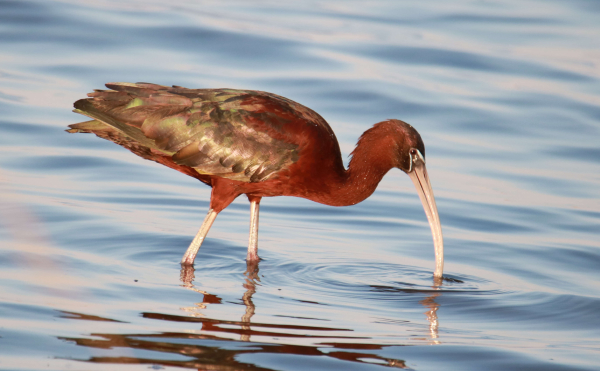
The interesting thing about these May ibis is that they are in full alternate (breeding) plumage, as colorful as you can imagine with their rich chestnut-colored body plumage set off by iridescent wing and tail feathers that reflect an array of colors as they turn from side to side in the sunlight. The real surprise came Saturday evening as I was focused on a stunning ibis, then I realized this bird’s white coloration on its face was actually an obvious shade of blue. Was this blue hue an intensified version of white? Other White-faced Ibis I checked had white facial markings and blood-red eyes that also caught my attention. But now my thoughts turned to the possibility that the blue-faced ibis might be a Glossy.
But Glossy Ibis range along the Gulf Coast from southern Louisiana to the south end of Florida, then up the Atlantic Coast to Nova Scotia, at least. While I recently explored birding sites along the Gulf Coast, especially in Florida and Louisiana, I didn’t have a chance get a close look at any Glossy Ibis. In fact, I didn’t see many Glossy Ibis anywhere along the Gulf or Florida’s Atlantic Coast wetlands, nor have I ever been around Glossy Ibis when they are in full color during the spring and summer nesting season. Therefore I had questions that needed to be answered about the ever-more interesting blue-faced ibis. And the best place to look for answers is the ultimate reference site – Birds of the World.
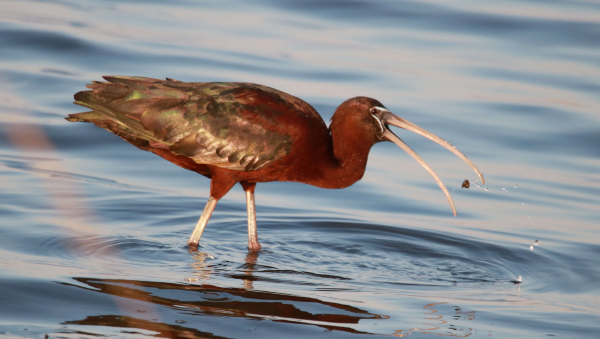
I checked the species account description of Glossy Ibis, and for White-faced Ibis, and both provided telltale information about the true identity of the blue-faced ibis. Both species have an area of bare skin that extends between the eyes and the bill. Among adult Glossy Ibis, the bare black skin is bordered by a pale blue line on the top and bottom edges of the skin from the bill to the brown eyes – without continuing around the eyes.
White-faced Ibis have bright red eyes and red skin between each eye and the bill with a broader white line on the top and bottom of the facial skin that circles behind their eyes – and those features are the easiest way to discern the species during the pre-nesting and nesting seasons. Case closed – the blue-faced ibis is a far offcourse Glossy Ibis!
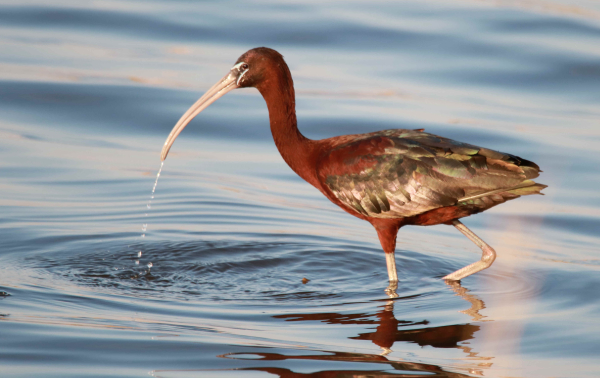
Documenting a Rare Bird Sighting
So the ID questions were answered, but there was still the fact that a Glossy Ibis would be far beyond the species’ normal range. Glossy Ibis are not unheard of in North Dakota, but they are very rare. They may be more common than we think though, because most birders expect that any ibis in the state is going to be a White-faced Ibis rather than scrutinizing each ibis to check for blue facial lines. Indeed, this is a species known for colonizing new areas, having expanded their nesting range in the 20th Century from Florida to Maine and northward to locations in Canada’s Maritime Provinces. And for now, I will be checking each local ibis for its true identity now that my interest has been piqued.
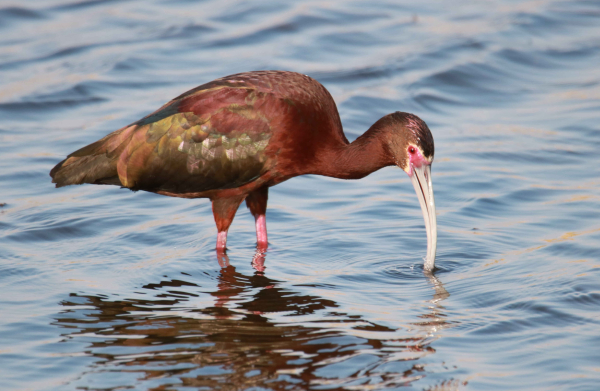
Appreciating the Tamron Zoom Lens
My documentary photos of the 2 ibis species were taken with the versatile Tamron 150-to-600mm zoom lens that I described in last week’s article. Each week I use this lens I appreciate it more – for the quality of photos it produces, it’s increased magnification into the 450 to 600mm range, it’s fast and accurate autofocus, and because it can be handheld with the aid of the excellent Vibration Compensation feature that minimizes the effect of “vibrations” created when we humans handhold cameras and binoculars. For the ibis photos, the Tamron zoom lens not only provided documentary photos, but also some of my personal best photos of Glossy Ibis.
Part of the reason I was drawn to try to photograph the ibis, along with avocets and sandpipers, was the calm beautifully colored water Saturday evening; and that color changed a bit by 15 minute increments, providing different shades of blue as a background waterscape, and as a whisp of wind blew by, it provided a bit of texture to the water color. The Tamron lens reproduced accurate water colors, but better yet, it recorded the vibrant iridescent hues of the ibis’s wings and tail that vary from shining gold and silver to olive green and violet. And most important of all, the photos show the identifying blue or white facial coloration that distinguishes the ibis species.
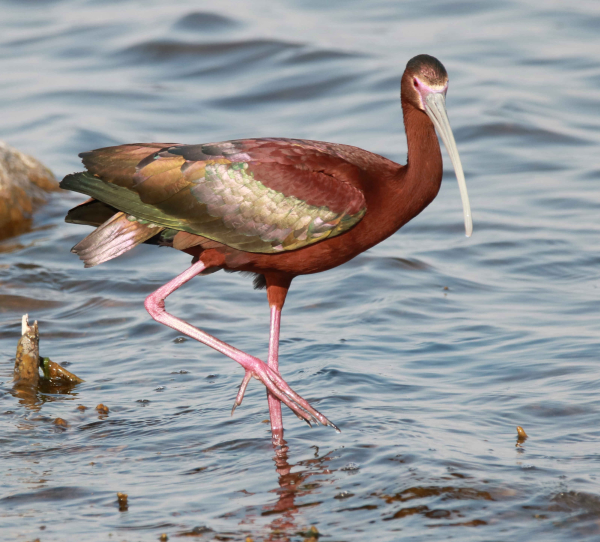
With the sun low, I used a narrow f6 aperture, which provided a 1/640 shutter speed using the Aperture Priority setting on my camera. The birds were great, and provided exceptional opportunities to photograph them as they foraged along the shallows of the marsh’s perimeter; they are impressive birds that will continue to attract my attention. The combination of a camera and lens certainly provides an excellent birding tool beyond its photography options. It provides a means of analyzing and assessing the contents of a given photo long after the image is taken. Oh what fun it is to be a birder who enjoys photographing birds! Good Luck, and stay alert!
Article and photos by Paul Konrad
Share your bird photographs and birding experiences at editorstbw2@gmail.com